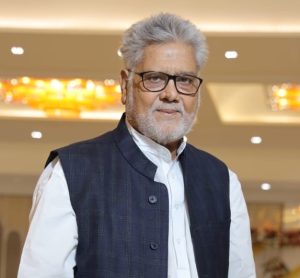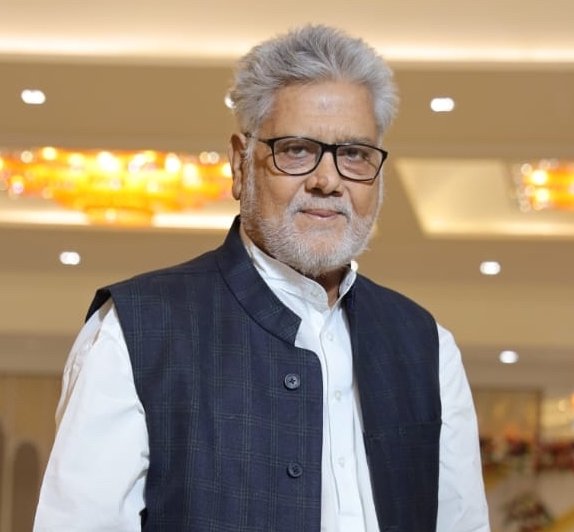Interview - Hasan Imam

Hasan Imam is a rare and distinguished exponent of sozkhwani, the traditional recitation of elegiac poetry dedicated to Imam Hussain and martyrs of Karbala, uniquely blending it with classical ragas and raginis. Rooted in Amroha’s distinct cultural tradition, his renditions of salams and marsiyas—in ragas such as Bharavi, Jaunpuri, Kedara, Peelu, Alhaiya Bilawal, and Malkauns—reflect a rich heritage passed down through generations, which he continues to share, including with his own family. Hasan Imam has preserved a refined art form that weaves together poetry, musical notes, and mourning. He’s also written books like ‘Taqqaiyyulat’ and ‘Shahe Lauho Qalam’.
He resides in Guzri, Amroha.
1. Tell us about your family background.
My name is Syed Hasan Imam Naqvi, and I was born on 25 June 1953. I am now retired. My academic qualifications include an M.A. and a B.Ed.
I am the younger son of Syed Saqi Hasan. My brother, Syed Ali Imam Naqvi, was employed by KDA (Karachi Development Authority) in Pakistan.
My father was a respected historian and a distinguished translator of his era. He translated several government-approved books from English into Urdu. He also authored around ten books. He served as the principal of the Imamul Madaris Inter College, Amroha.
My ancestor, Syed Asghar Husain, was a distinguished historian. His work, Tareekh-e-Asghari, was the first historical book on Amroha written in Urdu. It has been published several times and was translated into English a few years ago.
2. Do you recall any childhood memory that connects you to your art?
I remember, as a ten-year-old, how sozkhwani (elegy recitation) was deeply embedded in our house. Both my father and my uncle, Syed Taqi Hasan, were excellent sozkhwan (reciters of elegies). In my childhood, I had the privilege of listening to renowned reciters such as Muttaqi Hasan, Dada Jhabbu, and Sibtain Ahmad ‘Naina’. I also heard Syed Yasir Husain of Mohalla Guzri, whose son, Syed Shane Haider, recites soz with me.
I clearly remember when Sibtain Ahmad came to Amroha from Karachi. He was my father’s maternal uncle. He once seated me in his lap and recited a marsiya (elegy) by Chhannu Lal Dilgeer on the 20th of Safar (the second month of the Islamic calendar), which was traditionally recited during the Chehlum tazia procession in Amroha. I vividly remember that he had me recite the third line aloud, guiding me with great affection and love. That memory and his kindness remain with me to this day.
After reaching Karachi, a year or two later, he wrote a letter to my father — which I still have preserved — in which he said: “Hasan Imam’s sozkhwani must be at its peak. He must be reciting well.”
3. How did your journey in sozkhwani start?
My journey in sozkhwani began when I was just twelve or thirteen years old. I thank God that He blessed me with a melodious voice. The environment at home helped me develop this art.
During Muharram (1st to 10th), I regularly perform sozkhwani at Imambada Sughran and Imambada Alamdar Ali Khan , and during Arba’een (11th Safar to 20th Safar), at Imambada Alamdar Ali Khan.
4. Did your art travel outside the traditional Muharram commemoration?
I am proud to say that once, in the Kothi of Alay Ahmad Sahib in Amroha, Kamal Amrohi had my recital of ‘Husain jab ke chale baade do pahar rn ko’ recorded on tape. That recording was later played to Lata Mangeshkar, who then adapted it for the film Shankar Hussain.
5. You have a classical style of rendering soz (elegiac recitation). How different is it?
It is a fact that our Guzri and Bagla style of sozkhwani is distinct from that of all other schools in Amroha. It is rendered in almost every raag and raagini (musical modes).
The soz that I recite are composed in various ragas and raginis. The soz recited during formal sozkhwani sessions are different, while the soz recited during matam (mourning rituals)—which, in Amroha, follows a unique traditional style—are of a different kind altogether.
Even the marsiyas (elegiac poems) are composed in different ragas and raginis, and each marsiya has its unique pitch. The style in which these are recited is different from that found in other regions outside of Amroha. Each marsiya has its tone, temperament, and expression—no two are alike. Similarly, salams (poetic tributes to martyrs) are also composed in different musical modes.
Many of these salams, however, I have not yet had the opportunity to perform in full. If life permits, I hope to do so in the future.
6. Can you give a few examples of the raga used in salams?
The salams are also set in various ragas. Most of the salams I recite are those written by my uncle Taqi Hasan, as well as by poets like Meer Anees, Mirza Dabeer, Meer Munis, Dilgeer, and other notable poets of Amroha.
We present these salams in different ragas and styles. For example:
- A salam ‘sab mujhe zaakir-e-shah-e-shohada kahte hain’ (everyone calls me the reciter of the king of martyrs) by Meer Munis is in raga bhairavi.
- A salam ‘ameer jis dare daulat pa ek zamana hua’ (o prince of faith, it has been an age since you stood at the doorstep of worldly riches) by Meer Anees is in raga jaunpuri.
- A salam ‘Unko mujra sham mei naizon pe jin k sar gaye’ (they were made to bow in the court of Damascus—those whose heads had been raised on spears) by Dilgeer is in raga kedara. This salam is especially beloved because Dilgeer, a Hindu poet, was also an early marsiya-go (composer of elegies), and a historically significant one at that.
7. Is there any specific place where you have always wanted to perform?
I have had the honour of performing sozkhwani at various esteemed institutions and venues across India, including colleges and institutes in Delhi, Ansari Auditorium, Jamia Millia Islamia, Ghalib Academy, India Habitat Centre, Islamic Centre, Iran Cultural House, and Raza Library in Rampur. I was also privileged to recite marsiya at Kothi Khas Bagh, Rampur, during the Chehlum of Afaq Zamani.
Beyond India, I had the spiritual privilege of reciting marsiyas at the shrines of Imam Reza in Iran, Imam Hussain and Mukhtar al-Thaqafi in Iraq. During my visit to Pakistan, I was also fortunate to perform marsiyas at several azakhanas.
For all these opportunities, I am genuinely grateful to the Almighty.
8. What future do you see for your art?
I have no formal disciples, but in this digital era, people learn from recordings and recite accordingly. Even my son, who recites with me, has learned just by listening and practising. He has picked it up well.
By the grace of God, those who continue to perform sozkhwani with me today include not only my senior companions but also a new generation of devoted young reciters. Among them are Shane Haider, Syed Samar Mujtaba, Syed Naqi Imam, Syed Zaid bin Ali, Husain Imam, Amir Abbas, Zia Haider, Haider Abbas, and Shariq Riaz.
You may consider these young individuals either my students or my companions in recitation. They are actively carrying forward this tradition, reciting with deep respect and growing skill.
Hasan Imam in conversation with Inam Abidi Amrohvi. (July 28th, 2025)

